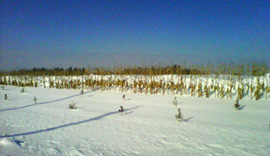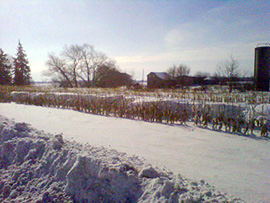Salt Reduction Initiatives
Salt Management Plan for Peel
We use our Salt Management Plan to guide how we use salt while ensuring safe driving conditions for travellers. Some of the tools we use for salt management include:
- Weather monitoring and forecasting with Road Weather Information Systems (RWIS) - RWIS is used to give advanced forecasting when weather events are heading into Peel so that the best winter road maintenance application is used. If you are travelling you can view current weather conditions at�Local Peel Weather, a public website.
- Snow Storage and Melt Water Treatment Facility�- If there are consecutive large snow events in a winter season, snow may need to be removed from the road boulevard to a separate snow storage facility. This dirty snow can be handled in an environmentally responsible way by ensuring it melts slowly and is treated before being released into the environment. A long-term snow storage facility is currently being investigated.
- Improved salt storage and handling�- We use best practices for salt storage and handling ensuring that we have enough product on hand and that it is protected from rain and snow.
- Route planning�- Route planning saves time, money and the environment through efficient use of anti-icing applications.
Snow Fencing

Our Natural Snow Fence Program began at 500 metres and has grown to 12,000 metres.
Drifting snow creates challenges and hazardous driving conditions. Snow fences help to keep blowing snow off the road resulting in less salt usage, fewer truck trips and less fuel consumption.
We use 3 different types of fences to manage blowing snow:
- Wooden snow fences�can be installed on residential properties annually in the fall and removed in the spring by authority of the�Municipal Act
- Natural snow fences�use existing corn crops purposely left on the field over the winter season to act as a natural barrier to blowing snow. Farmers are financially compensated for leaving the crop standing over the winter and can harvest it in the spring.
- Living Snow Fences use planted trees and shrubs located just outside of the road right-of-way along rural roads to reduce the effects of blowing snow. Plants are considered a permanent fixture and are supplied at no cost to the landowner in a partnership with Conservation Authorities.
For further information on participating in either the Natural Snow Fence or Living Snow Fence program, please call 905-791-7800.
A living snow fence is a barrier created by plants, shrubs and trees to reduce snow blown across roads.
Planting trees and shrubs is not only more attractive and more environmentally-friendly than building a wood fence, but also more convenient than putting up and taking down traditional snow fences.
Benefits of Participating
When you take part in the Living Snow Fence program, everyone wins.
You:
- Get free trees and shrubs!
- Get year-round beautification and the plants help screen your property from the road.
- Enhance your property.
We:
- Work with you to pick the trees and shrubs that best suit your property.
- Customize a planting plan.
- Buy the trees and shrubs for you and do the planting work for free.
- Improve road safety as the living fence grows.
Qualifiying for a Living Snow Fence
You'll qualify for a living snow fence if:
- Your property fronts the west or north side of a Peel Regional Road.
- You have approximately 30 metres of set back from the right of way.
- You currently have a wooden snow fence(s) installed in the winter.

To learn more about the Living Snow Fence Program, call 905-791-7800 ext. 4409
Partners
The Region of Peel partners with the following organizations to build living snow fences throughout Peel:

Snow fences force wind to go around and through a fence. This causes the wind to lose energy and speed.
As the speed of the wind slows, the snow forms a drift before or behind the snow fence. How much snow a fence traps depends on the height of the fence and the amount of snow that falls.
The Region installs manufactured snow fences on residential properties next to roadways that experience lots of blowing snow.
Alternatively, a natural snow fence is a snow face created by corn crops. The rows of standing corn left after the harvest provide a barrier that controls blowing and drifting snow.
Participating Farmers Keep Roads Safer
The Region of Peel established the Natural Snow Fence Program with the help of Peel farmers whose properties were next to Regional roads. The Region uses a small portion of the farm corn crop (approximately 12 to 15 rows of corn) as natural snow fences during the winter to improve winter road safety.
As a participating farmer, you'll
- Receive money as compensation from the Region of Peel.
- Help minimize snow drifts and ice to keep the Region's roads safer.
- Help us save on material and fuel costs of operating snow plows.
Qualifying
To qualify for the Region's Natural Snow Fence program:
- You must be able to leave up a portion of your corn crop (approximately 12 to 15 rows of corn) as a barrier.
- Your property must be located next to a Regional road.





